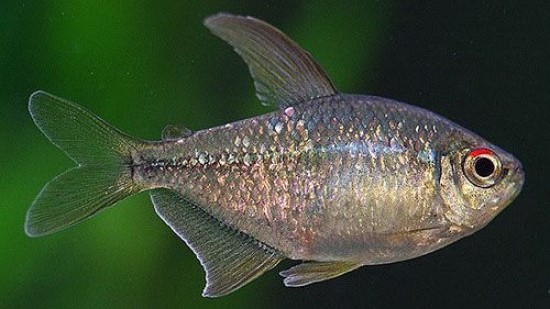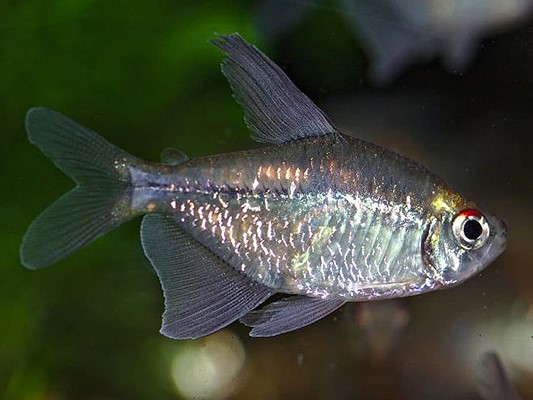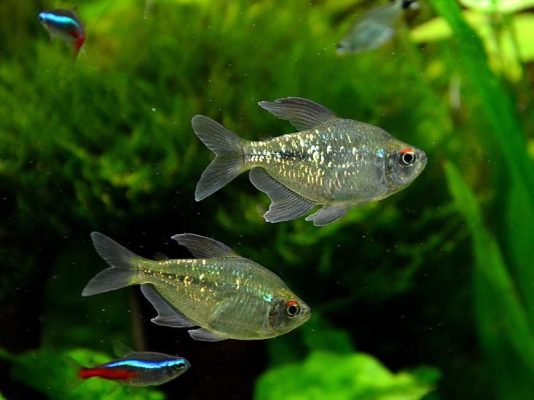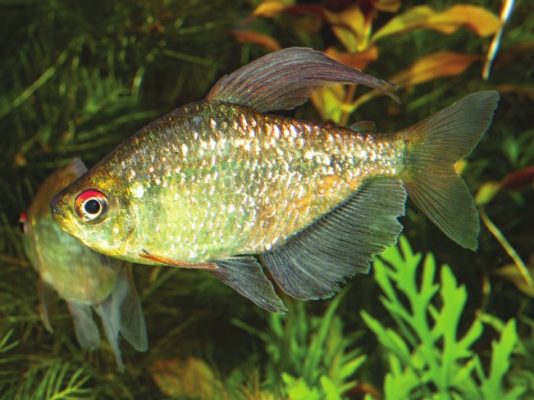Diamond Tetra

Table of Contents
Introduction
Moenkhausia pittieri, commonly known as the Diamond Tetra, is a species of freshwater fish that has gained significant popularity among aquarium enthusiasts. Its unique characteristics and stunning appearance make it a highly sought-after species for fishkeepers worldwide.
The Diamond Tetra is known for its diamond-shaped iridescent scales, which shimmer and reflect light, giving it a captivating and elegant appearance. This striking feature is what earned it the name “Diamond Tetra.” Its vibrant colors, ranging from silver to gold, further enhance its visual appeal.
Beyond its popularity in the aquarium trade, Moenkhausia pittieri plays a crucial role in the aquatic ecosystem. As a prey species, it serves as a vital food source for larger fish and predatory species. Its abundance and availability contribute to the overall biodiversity and ecological balance of freshwater ecosystems.
Moreover, Moenkhausia pittieri’s interactions with other organisms, such as its feeding habits and reproductive behavior, have significant implications for the functioning of the aquatic food web. Understanding and appreciating the ecological importance of this species is essential for the conservation and preservation of our natural habitats.
By delving into the taxonomy, habitat, behavior, reproduction, and conservation status of Moenkhausia pittieri, this article seeks to provide readers with a deeper appreciation for this unique species. Through a thorough examination of its characteristics and ecological significance, we can gain a comprehensive understanding of the Diamond Tetra and its importance in maintaining the health and balance of freshwater ecosystems.
Taxonomy
Classification of Diamond tetra
Moenkhausia pittieri, commonly known as the Diamond Tetra, belongs to the family Characidae within the order Characiformes. Its scientific classification is as follows:
- Kingdom: Animalia
- Phylum: Chordata
- Class: Actinopterygii
- Order: Characiformes
- Family: Characidae
- Genus: Moenkhausia
- Species: Moenkhausia pittieri
Description of its physical characteristics
Moenkhausia pittieri is a visually striking fish with unique physical characteristics that set it apart from other species. It typically reaches a size of around 2.5 inches (6.5 cm) in length, making it a relatively small fish in the aquarium hobby.
One of the most distinctive features of Moenkhausia pittieri is its diamond-shaped iridescent scales, which give it its common name. These scales reflect light and create a shimmering effect, adding to the fish’s overall beauty. The coloration of the Diamond Tetra varies from a silvery-white to a pale yellow, with a slight iridescence that catches the eye.
Compared to other related species, Moenkhausia pittieri has a slender and elongated body shape. Its dorsal fin is positioned towards the back of the body, and it has a small adipose fin located between the dorsal and caudal fins. The caudal fin is forked, allowing for precise and agile swimming movements.
In terms of sexual dimorphism, male and female Diamond Tetras can be distinguished by their body shape and coloration. Males tend to have a more streamlined body shape, while females have a slightly rounder abdomen. Additionally, males may exhibit more intense coloration during the breeding season, with brighter hues and more prominent iridescence.
When comparing Moenkhausia pittieri to other species within the Moenkhausia genus, it is important to note that there are several closely related species that share similar physical characteristics. However, each species has its own distinct coloration patterns and scale arrangements, allowing for easy differentiation.
By providing a detailed description of Moenkhausia pittieri’s physical appearance, including its size, shape, coloration, and unique diamond-shaped iridescent scales, readers can gain a clear understanding of the visual appeal and distinctiveness of this species. Comparisons with related species further enhance the reader’s knowledge and appreciation of the Diamond Tetra’s physical characteristics.
Habitat
Natural distribution of Diamond tetra
Moenkhausia pittieri, commonly known as the Diamond Tetra, is native to the freshwater ecosystems of Venezuela. Its natural distribution is primarily concentrated in Lake Valencia, a large lake located in the northern part of the country. Lake Valencia is renowned for its rich biodiversity and serves as a crucial habitat for various aquatic species, including Moenkhausia pittieri.
In addition to Lake Valencia, Moenkhausia pittieri can also be found in other regions of Venezuela, such as the rivers and streams that flow into the lake. These water bodies provide additional habitats for the species, allowing them to thrive in diverse environments.
Description of its preferred habitats
Moenkhausia pittieri typically inhabits rivers, streams, and other freshwater bodies in its natural habitat. These habitats provide the necessary conditions for the species to survive and reproduce. The Diamond Tetra is known to prefer areas with slow to moderate water flow, as it allows them to swim comfortably and exhibit their natural behaviors.
Within these habitats, Moenkhausia pittieri is often found near submerged vegetation, such as aquatic plants and fallen branches. These structures provide hiding places and shelter for the fish, as well as serve as a source of food and protection from predators.
Factors influencing its habitat selection
Several environmental factors influence the habitat selection of Moenkhausia pittieri. Water temperature is a crucial factor, with the species preferring temperatures between 72°F and 82°F (22°C and 28°C). They are sensitive to extreme temperature fluctuations and may become stressed or susceptible to diseases if exposed to unsuitable conditions.
Water quality is another important factor for the Diamond Tetra. They thrive in clean, well-oxygenated water with a pH level ranging from 6.5 to 7.5. Moenkhausia pittieri is particularly sensitive to high levels of ammonia, nitrite, and nitrate, which can be harmful to their health. Maintaining optimal water quality is essential for their well-being, both in their natural habitat and in aquariums.
The presence of vegetation is also significant for Moenkhausia pittieri. They rely on aquatic plants for shelter, breeding, and foraging. The plants provide hiding places for the fish, allowing them to feel secure and protected from potential predators. Additionally, the vegetation serves as a source of food, as Moenkhausia pittieri feeds on small insects and larvae that inhabit these plants.
Understanding these factors that influence the habitat selection of Moenkhausia pittieri is crucial for providing appropriate care and maintenance in aquariums. By replicating their natural habitat conditions, fishkeepers can ensure the well-being and longevity of these beautiful and fascinating fish.
Behavior
Social behavior and hierarchy within Diamond tetra schools
Moenkhausia pittieri, commonly known as the Diamond Tetra, exhibits fascinating social behavior within their schools. These fish are highly social and form tight-knit groups, known as schools, consisting of individuals ranging from a few to several dozen. Within these schools, a clear hierarchy is established, with dominant individuals exerting control and leading the group.
Studies have shown that the hierarchy within Moenkhausia pittieri schools is based on size and age. Larger and older individuals tend to occupy the higher ranks, while smaller and younger fish occupy the lower ranks. This hierarchical structure is maintained through various behavioral interactions, such as displays of aggression and submission.
Dominant individuals in the school display their status through aggressive behaviors, including fin flaring, chasing, and nipping at subordinate individuals. These dominant fish also have priority access to food resources and preferred territories within the aquarium or natural habitat.
Subordinate individuals, on the other hand, exhibit submissive behaviors to avoid conflicts with dominant individuals. They may display submissive postures, such as lowering their fins and body, and avoid direct confrontation with dominant fish. Subordinates often follow the lead of dominant individuals and rely on their guidance for foraging and navigating their environment.
It is important to note that the establishment of a hierarchy within Moenkhausia pittieri schools does not necessarily lead to constant aggression or stress. The social structure helps maintain order and coordination within the group, allowing for efficient communication and collective decision-making.
Feeding habits and diet preferences
Moenkhausia pittieri is an omnivorous species with a varied diet. In the wild, they primarily feed on small insects, larvae, and other invertebrates found in their natural habitat, such as rivers and streams. Their ability to consume small prey items makes them an important part of the aquatic food chain.
In aquariums, it is essential to replicate their natural diet to ensure their optimal health and well-being. While they can adapt to commercially available fish foods, it is recommended to provide a balanced diet that includes a mix of live and frozen foods. This can include small live or frozen invertebrates, such as bloodworms, daphnia, and brine shrimp, which mimic their natural prey.
It is important to note that Moenkhausia pittieri is an active swimmer and requires regular feeding to meet their energetic needs. Feeding should be done in small portions multiple times a day to mimic their natural foraging behavior. This not only ensures their nutritional requirements are met but also provides mental stimulation and prevents boredom.
Swimming patterns and activity levels
Moenkhausia pittieri is known for its active swimming patterns and high activity levels. They are highly adaptable and can thrive in various aquatic environments, including open water habitats. Their streamlined body shape and powerful fins allow them to navigate swiftly through the water column with ease.
In aquariums, Moenkhausia pittieri should be provided with ample swimming space to accommodate their active nature. A well-maintained tank with open areas for swimming and the presence of plants or other structures for shelter and exploration is ideal. This allows them to exhibit their natural swimming behaviors and explore their environment.
Observations in aquarium settings have shown that Moenkhausia pittieri tends to swim in a coordinated manner within their schools. They often form tight formations and move together as a cohesive unit, displaying synchronized swimming patterns. This behavior not only enhances their social cohesion but also provides them with a sense of security and protection against potential predators.
Response to environmental stimuli (light, temperature changes, etc.)
Moenkhausia pittieri exhibits interesting responses to various environmental stimuli, including changes in light and temperature. These responses are thought to be adaptations that help them survive and thrive in their natural habitat.
In terms of light, Moenkhausia pittieri shows a preference for moderate to dim lighting conditions. Bright, intense lighting can cause stress and discomfort, leading to decreased activity levels and potential health issues. Providing diffused or subdued lighting in their aquarium helps create a more natural and comfortable environment for these fish.
Temperature changes can also influence the behavior of Moenkhausia pittieri. They are native to tropical regions and prefer water temperatures between 72°F to 82°F (22°C to 28°C). Sudden fluctuations in temperature can be stressful for these fish and may affect their overall well-being. It is important to maintain a stable and suitable temperature range within their aquarium to ensure their comfort and health.
Additionally, Moenkhausia pittieri is known to exhibit photoperiodic responses, meaning their behavior can be influenced by changes in the duration of light and darkness. Adjusting the lighting schedule in their aquarium to mimic natural day-night cycles can help regulate their biological rhythms and promote natural behavior.
Understanding and respecting these responses to environmental stimuli is crucial for providing optimal care and maintaining the well-being of Moenkhausia pittieri in both aquarium and natural settings. By creating an environment that closely resembles their natural habitat, we can ensure these fascinating fish thrive and exhibit their natural behaviors.
Reproduction
Description of Diamond tetra’s Reproductive Strategies
Moenkhausia pittieri, like many other fish species, employs various reproductive strategies to ensure the survival and continuation of its population. These strategies have evolved over time to optimize reproduction and increase the chances of successful offspring production.
One of the key reproductive strategies of Moenkhausia pittieri is its reliance on external fertilization. This means that fertilization occurs outside the body, in the water, rather than internally like in mammals. This strategy allows for the production of a large number of eggs, increasing the chances of successful fertilization and survival of the species.
Courtship and Mating Rituals
During the courtship phase, Moenkhausia pittieri engages in a series of displays and behaviors to attract potential mates. Males often exhibit vibrant colors and patterns, such as intensified iridescence on their diamond-shaped scales, to signal their readiness to reproduce. These displays not only attract females but also serve as a means of competition among males, as they vie for the attention of the females.
Once a male has successfully attracted a female, they engage in a courtship dance, where they swim together in synchronized movements. This dance serves to establish a bond between the pair and ensure compatibility for successful reproduction. The male may also perform specific movements, such as quivering or chasing, to further demonstrate his suitability as a mate.
Spawning Behavior and Egg-laying Preferences
Moenkhausia pittieri typically spawns in shallow, densely vegetated areas of their natural habitat, such as the edges of rivers or streams. The female releases her eggs, while the male simultaneously releases his sperm, resulting in external fertilization. The adhesive eggs then attach to the vegetation or other submerged surfaces, providing protection from predators and environmental factors.
The spawning process is often triggered by environmental cues, such as changes in water temperature or the availability of suitable spawning sites. These cues signal the optimal conditions for reproduction and ensure the survival of the offspring.
Parental Care and Survival Rates of Offspring
After the eggs are laid, Moenkhausia pittieri exhibits minimal parental care. The male may guard the spawning site and defend it from potential threats, but there is no active involvement in protecting or caring for the eggs or fry. The eggs hatch within a few days, depending on water temperature and other environmental factors, and the fry emerge.
The survival rates of the offspring largely depend on the availability of suitable food sources and the presence of predators. The fry are initially very small and vulnerable, making them easy targets for larger fish and other aquatic predators. However, their sheer numbers and the protective nature of the spawning site help increase the chances of survival.
In conclusion, Moenkhausia pittieri employs external fertilization as its primary reproductive strategy, relying on courtship displays, synchronized movements, and spawning in specific habitats to ensure successful reproduction. While minimal parental care is provided, the survival rates of the offspring depend on various factors, including food availability and the presence of predators. Understanding these reproductive strategies is crucial for the conservation and management of Moenkhausia pittieri populations in both their natural habitats and aquarium settings.
Human Interaction
Diamond tetra as a popular aquarium fish
Moenkhausia pittieri, commonly known as the Diamond Tetra, has gained significant popularity among aquarium enthusiasts worldwide. Its unique characteristics and striking appearance make it a highly sought-after species for both beginner and experienced fishkeepers.
One of the main reasons for its popularity is its stunning physical appearance. Moenkhausia pittieri is characterized by its diamond-shaped iridescent scales, which give it its common name. These scales reflect light in a way that creates a dazzling display of colors, making it a visually captivating addition to any aquarium.
Furthermore, the peaceful nature of Moenkhausia pittieri makes it an excellent choice for community tanks. It is known to be compatible with a wide range of other fish species, making it a versatile option for aquarists looking to create a harmonious and visually appealing aquatic environment.
Challenges and considerations for keeping Diamond tetra in captivity
While Moenkhausia pittieri is a popular choice for aquariums, there are certain challenges and considerations that aquarists need to be aware of in order to provide optimal care for these fish.
Firstly, Moenkhausia pittieri requires a well-maintained and properly established aquarium environment. They thrive in freshwater with stable water parameters, including a pH level between 6.5 and 7.5 and a temperature range of 72-82°F (22-28°C). It is essential to regularly monitor and maintain these conditions to ensure the health and well-being of the fish.
Additionally, Moenkhausia pittieri is a schooling fish, which means they prefer to be kept in groups of at least six individuals. Providing a suitable tank size that can accommodate a school of Diamond Tetras is crucial for their overall happiness and behavior. A tank with a minimum capacity of 20 gallons is recommended to provide ample swimming space and to prevent overcrowding.
Furthermore, Moenkhausia pittieri is an active species that appreciates a well-planted aquarium with plenty of hiding spots and open swimming areas. The presence of live plants not only enhances the aesthetic appeal of the tank but also provides natural cover and helps to mimic their natural habitat.
Responsible aquarium trade practices and sustainable sourcing
As the popularity of Moenkhausia pittieri continues to grow, it is essential to promote responsible aquarium trade practices and sustainable sourcing to ensure the long-term survival of this species in the wild.
Responsible aquarium trade practices involve ensuring that fish are sourced from reputable breeders or suppliers who prioritize the health and welfare of the fish. It is important to support businesses that adhere to ethical standards and avoid purchasing fish from sources that engage in harmful practices such as illegal collection or destructive fishing methods.
Sustainable sourcing is another crucial aspect of responsible fishkeeping. Aquarists should prioritize purchasing captive-bred Moenkhausia pittieri whenever possible. Captive breeding not only helps to reduce the pressure on wild populations but also ensures that the fish are better acclimated to aquarium conditions and have a higher chance of survival in captivity.
Furthermore, supporting conservation organizations and initiatives that work towards the preservation of Moenkhausia pittieri and its natural habitat is vital. By raising awareness and contributing to conservation efforts, aquarists can play an active role in protecting this species and its ecosystem for future generations.
In conclusion, Moenkhausia pittieri’s popularity as an aquarium fish is well-deserved due to its unique characteristics and stunning appearance. However, it is crucial for aquarists to be aware of the challenges and considerations associated with keeping these fish in captivity. By practicing responsible aquarium trade and supporting sustainable sourcing, we can contribute to the conservation of Moenkhausia pittieri and ensure its long-term survival in both the wild and the aquarium trade.
Conclusion
Throughout this article, we have delved into the fascinating world of Moenkhausia pittieri, commonly known as the Diamond Tetra. We started by providing a brief overview of this species, highlighting its popularity among aquarium enthusiasts and its unique characteristics that make it a favorite among fishkeepers. We then explored the importance of Moenkhausia pittieri in the aquatic ecosystem, discussing its role in maintaining biodiversity and ecological balance as a prey species and its interactions with other organisms.
Moving on, we delved into the taxonomy of Moenkhausia pittieri, providing its scientific classification and discussing its taxonomic relationships with other fish species. We also described its physical characteristics in detail, focusing on its size, shape, and the stunning diamond-shaped iridescent scales that give it its common name.
Next, we explored the habitat preferences of Moenkhausia pittieri, describing its native range in Lake Valencia, Venezuela, and discussing the types of habitats it typically inhabits in the wild, such as rivers and streams. We also examined the environmental factors that influence its habitat selection, including water temperature, pH, and vegetation, and how these factors impact its care and maintenance in aquariums.
In terms of behavior, we delved into the social dynamics of Moenkhausia pittieri schools, explaining their schooling behavior and hierarchical structure. We also discussed their feeding habits and diet preferences, highlighting their need for a balanced diet that includes live and frozen foods. Additionally, we described their swimming patterns, activity levels, and their response to environmental stimuli such as changes in light and temperature.
Moving on to reproduction, we explored the reproductive strategies employed by Moenkhausia pittieri, including their breeding patterns and courtship rituals. We also discussed their spawning behavior and egg-laying preferences, as well as the parental care they exhibit towards their eggs and fry. Furthermore, we touched upon the survival rates of offspring and the challenges they face.
Shifting our focus to the conservation status of Moenkhausia pittieri, we provided an overview of its current conservation status, highlighting any threatened or endangered classifications. We also discussed the main threats to its population, including habitat destruction, pollution, and overfishing, and the impact of these threats on its survival. Additionally, we highlighted the ongoing efforts and initiatives aimed at conserving and protecting this species, including conservation programs, research projects, and legislation.
In the context of human interaction, we explored the popularity of Moenkhausia pittieri as an aquarium fish and the challenges and considerations associated with keeping it in captivity. We emphasized the importance of responsible aquarium trade practices and sustainable sourcing to ensure the well-being of this species.
Moenkhausia pittieri plays a crucial role in the aquatic ecosystem, contributing to biodiversity and ecological balance. As a prey species, it serves as a vital food source for larger predators, thus maintaining the delicate balance of the food chain. Its presence also helps regulate populations of other organisms, preventing overpopulation and potential ecological disruptions. Furthermore, the unique characteristics and behaviors of Moenkhausia pittieri make it a valuable indicator species for the overall health of freshwater ecosystems.
In conclusion, the comprehensive understanding of Moenkhausia pittieri presented in this article highlights the need for conservation efforts and raising awareness about this remarkable species. The threats it faces, such as habitat destruction, pollution, and overfishing, pose significant risks to its survival and the overall health of freshwater ecosystems. It is crucial that we take action to protect Moenkhausia pittieri and its habitat, not only for its own sake but also for the well-being of the entire aquatic ecosystem.
By supporting conservation programs, participating in research initiatives, and advocating for responsible aquarium trade practices, we can contribute to the long-term survival of Moenkhausia pittieri and help maintain the delicate balance of our freshwater ecosystems. Let us all be stewards of this remarkable species and work together to ensure a sustainable future for Moenkhausia pittieri and the countless other species that rely on healthy aquatic environments.



